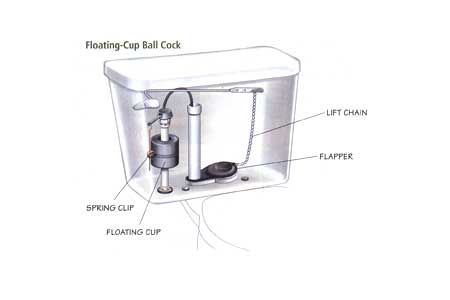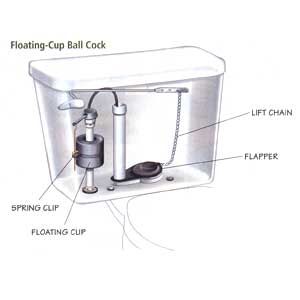
Before you start, turn off the water at the shutoff valve near the base of the toilet. If there isn’t one, read “Emergency Shutoff, ” which will fill you in on how to locate shutoff valves. Once the water is off, flush the toilet a couple of times. This empties the tank so you can make repairs. If you’re replacing the water-supply line or ball cock, sponge up the remaining water in the toilet tank. Next, check out your toilet-tank mechanism and match it to one shown on the following page before buying parts or reading up on the repairs that we describe. When buying parts, choose a kit (less than $20) rather than individual items. The kit will contain all of the working parts you need to repair your toilet. Buying a kit will also eliminate unnecessary trips to the hardware store or home center in the middle of the job.
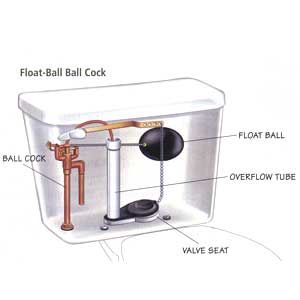
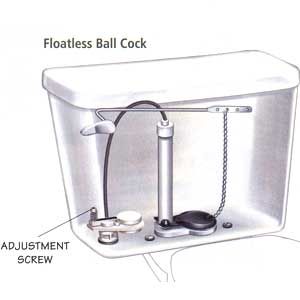
Gurgles, Ripples, Hissing
Problem: Gurgles, ripples in the bowl, or a hissing sound.
Solution: This problem usually indicates the water level is too high in the tank, with the excess pouring into the overflow tube. In a toilet with a float-ball ball cock, the ball at the end of a brass rod rises with the water as the tank refills. At a set water level, the rod-and-ball assembly turns off the diaphragm ball cock, shutting off source water. If the ball isn’t set low enough, water will crest and pour into the overflow tube. Stop this by gently bending down the rod by hand to lower the water level in the tank. For a floating-cup ball cock, a cup slides up the ball-cock shaft as the water level rises and lifts a wire that trips the ball cock off. To lower the water level, pinch the clip holding the floating cup to the wire and slide it down the ball-cock shank. For a floatless ball cock, turn the adjustment screw located at the base of the ball cock counterclockwise. Work the screw in half-turn increments. A new ball cock costs around $6.
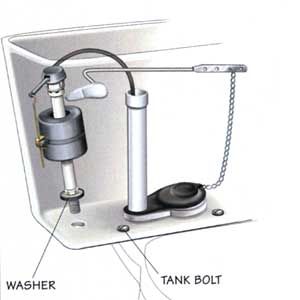
Water Goes On and Off
Problem: Water to the tank goes on and then off every 20 minutes or so. There may also be a gurgling sound.
Solution: A leaky valve seat, the exit hole at the bottom of the tank, usually causes these problems. Here are the two possible scenarios: The flapper (or tank ball in some older toilets) should seal the valve. If the valve is caked with mineral deposits, it can leak. Scrub the valve seal (and tank ball or flapper if necessary) with distilled white vinegar and a scouring pad. Another possibility is that the flapper or tank ball is misaligned or damaged. Inspect it for cracks, rips, or tears, and adjust or replace it if necessary. For a flapper, make sure it’s centered and square to the overflow tube. If you need to replace the flapper, simply unhook it and install a new one. For a misaligned tank ball, adjust the wire until the ball fits snugly. To replace a tank ball, just unscrew it. Older ones often disintegrate when handled, so unscrew the ball mount with pliers.
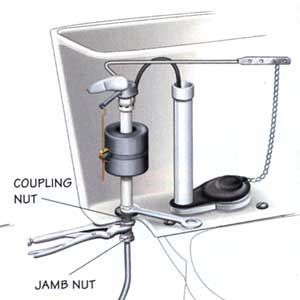
Water Leaks Out of the Bottom of the Tank
Problem: Water leaks out of the bottom of the tank.
Solution: There are three possibilities here. The bottom of the ball cock could be leaking, the connection between the external water-supply line and the ball cock could be loose, or the tank bolts might have corroded, causing water to seep out. The water-supply line feeds water into the threaded ball-cock tailpiece that protrudes from the bottom of the tank. It’s held in place by a jamb nut that screws up from the bottom outside of the tank. Try tightening the nut as a first step. If that doesn’t work, replace the ball cock (around $6). Unscrew the supply-line coupling and detach the line. Then unscrew the jamb nut and pull the ball cock out. Fit a new washer over the new ball cock and coat the bottom of this cone-shaped washer with Teflon pipe dope. Thread the jamb nut by hand, then tighten with a wrench. Be sure to buy an antisiphon ball cock, which prevents the backflow of contaminated wastewater. Another possibility is that there’s a leaking connection between the supply line and tailpiece. To repair the connection, unscrew the supply-tube coupling and replace the line with durable braided-stainless-steel line (around $6). Bring the old one to the store to match coupling sizes and line length. Coupling sizes are 3/8, 1/2, and 7/8 inch. Check both ends because many supply lines are 3/8 inch on one end and 1/2 inch on the other. If the shutoff valve is leaking, replace it with a stainless-steel one for around $6. In an older toilet, leaky tank bolts are another possible cause of a leak. First, try gently tightening the bolts (overtightening can crack the tank). If the leak persists, replace the rubber washers inside the tank or the bolts themselves if they’re corroded.
Toilet Leaks at Floor Level
Problem: Toilet leaks at floor level.
Solution: If water is oozing from under the toilet or the flooring is damp, the seal made by the wax ring that connects the bottom of the toilet and the top of the waste pipe, called a closet flange, is broken. Try gently tightening (one full turn, maximum) the nuts that hold the toilet to the floor. If the problem persists, replace the wax ring.
